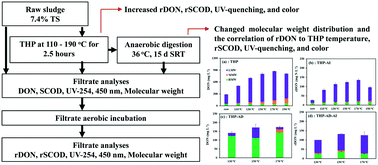Understanding the formation of recalcitrant dissolved organic nitrogen as a result of thermal hydrolysis and anaerobic digestion of municipal sludge
Abstract
This study for the first time investigated the turnover of dissolved organic nitrogen (DON) in lab-scale thermal hydrolysis pretreatment (THP) operated for 2.5 hours at different temperatures with and without mesophilic anaerobic digestion (AD) at a solids retention time of 15 days. Results showed that THP at the temperature ranging from 110 to 190 °C substantially increased the levels of recalcitrant dissolved organic nitrogen (rDON) by 110–310% as defined by DON that can survive aerobic incubation for more than 3 days at oxygen utilization rates <0.002 ml L−1 h−1. At all THP temperatures, rDON made up 14–16% of the DON generated from THP and 71–77% of the DON coming out of the AD following THP. The mesophilic AD cannot reduce the total rDON level but increased the high molecular weight fractions of rDON, recalcitrant soluble chemical oxygen demand (rSCOD), color and UV-quenching. Because of this anaerobic transformation, the originally strong correlation of rDON to the THP temperature, rSCOD, color and UV-quenching disappeared after mesophilic AD.



 Please wait while we load your content...
Please wait while we load your content...